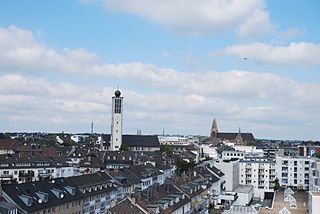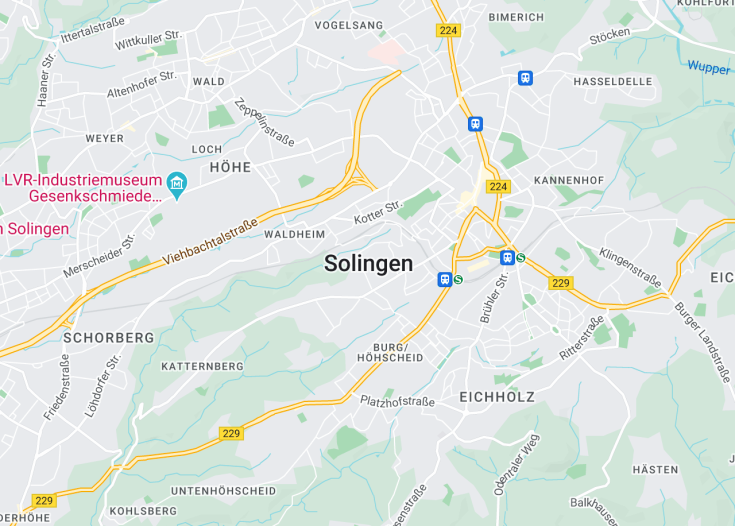Solingen, a revered destination in Germany, is renowned for its rich history in blade craftsmanship, often called the “City of Blades.” Nestled in North Rhine-Westphalia, it offers a blend of historical allure with its medieval architecture, and the scenic beauty of lush, surrounding landscapes. Renowned museums, like the Blade Museum, attract history enthusiasts while its proximate forests provide tranquil retreats for nature lovers. Solingen is a perfect harmony of cultural heritage and natural beauty, making it a compelling travel spot for those seeking depth and diversity in their journeys.
When visiting Solingen, ensure to explore both its historical bladesmith workshops and modern cutlery factories to fully appreciate the city’s renowned craftsmanship.
To make the most of your visit, consider a guided tour through Solingen’s picturesque castle, Schloss Burg, to delve deep into its medieval history.
Solingen: The City of Blades
| Country | Germany |
| Time in Solingen | GMT+1 |
| Language spoken | German |
| Population | 159,699 (Statista, 2022) |
| Currency | Euro (€, EUR) |
| Airports |
|
Situated in North Rhine-Westphalia, Germany, Solingen is an illustrious city renowned for its history and mastery in metal crafting, particularly knives, scissors, and blades, which has earned it the nickname “The City of Blades.” The city’s roots in metalwork can be traced back over centuries, making it a significant hub in the cutlery industry worldwide.
Throughout its history, Solingen has sustained its reputation through high-quality craftsmanship standards that are respected globally. This tradition began in the medieval period and has been preserved and evolved with modern techniques and innovation. Museums and historical sites within the city, like the Blade Museum, continue to celebrate this rich heritage, attracting visitors and professionals interested in the craft and history of metalwork.
Beyond its industrial significance, Solingen offers an array of cultural experiences, including robust local festivals that showcase the region’s folklore, culinary tastes, and artisan craftsmanship. The natural scenery surrounding the city—including the lush, rolling hills and well-preserved parks—provides a perfect backdrop for hiking and outdoor activities. This geographical setting not only amplifies the city’s picturesque quality but also enhances the quality of life for its residents.
With a robust public transportation network and proximity to major German cities like Cologne and Düsseldorf, Solingen ensures connectivity and accessibility, blending its historical charm with modern convenience. This connectivity is bolstered by nearby airports, making the city a practical location for both business and tourism.
In essence, Solingen represents a unique blend of historical significance, cultural richness, and modern efficiency, making it a notable destination in Germany for both historical enthusiasts and those intrigued by the art of metal crafting.
Where is Solingen?
Solingen is located in the Bergisches Land region of North Rhine-Westphalia, western Germany, situated between the cities of Düsseldorf and Cologne.
Distances:
| Route | Distance by car | Time by car |
|---|---|---|
| Düsseldorf to Solingen | 22 miles (35 km) | 40 minutes |
| Cologne to Solingen | 29 miles (47 km) | 50 minutes |
What is Solingen famous for?
Solingen is globally renowned for its high-quality cutlery and blades. Its century-long tradition in metal crafting has branded it as the “City of Blades.”
History
Prehistoric to Early Middle Ages
The history of Solingen, a city renowned for its cutlery industry, traces back to prehistoric times with early human activities in the region. The area’s significant archaeological finds suggest a continuous human presence from at least the Bronze Age. The first definitive settlement was recorded under the name “Solonchon” during the Early Middle Ages, indicating a well-established community focused on agriculture and tool-making.
1200s – Renaissance
By the 13th century, the name Solingen was adopted, and the town was granted city rights around 1374, a pivotal moment that underscored its growing importance in the region. During the late medieval period, Solingen became renowned for its blade production—a legacy initiated by the abundant local resources and the artisanal skills of its inhabitants. The Renaissance period propelled this reputation, with Solingen steel being sought across Europe.
Industrial Revolution to 20th Century
The onset of the Industrial Revolution marked a transformative era for Solingen as mechanization took root. The city adapted swiftly, integrating new technologies which further boosted its cutlery production. In the 19th and early 20th centuries, Solingen’s industrial base diversified, but the two World Wars brought inevitable challenges and reconstructions. Post-World War II recovery was rapid, reinstating its economic status and forging innovations in stainless steel craftsmanship.
Post-1945 to Present
In recent decades, Solingen has embraced modernization while retaining its historical charm and craftsmanship legacy. Today, the city continues to be a key player in the global cutlery and blade-making industry. It combines historical heritage with contemporary culture, showcasing museums, cultural institutions, and an ongoing commitment to quality and craftsmanship in manufacturing.
Visit Solingen
What to see and do in Solingen, Germany
Exploring Solingen offers a delightful blend of industrial heritage and natural beauty. Key attractions include:
- The Solingen Blade Museum which showcases the city’s famed history of blade-making.
- Burg Castle, one of the largest reconstructed castles in Western Germany, provides a glimpse into medieval times.
- Müngsten Bridge, Germany’s highest railway bridge, offering spectacular views and a park for leisure activities.
- The Botanical Garden, perfect for relaxation and a close look at local and exotic plant species.
In addition to these sights, Solingen invites visitors to partake in guided tours of its historic factories to witness the precision of blade crafting firsthand.
Annual events in Solingen
Throughout the year, Solingen hosts various cultural and traditional events that reflect its rich heritage and community spirit. Noteworthy events include the Solingen Gräfrather Klingenmarkt, a knife market held annually in September, where local and international craftsmen display their finest works. The Christmas market, set up from late November to December, offers a festive experience with traditional German treats and handicrafts.
Best time to visit Solingen
The optimal time to visit Solingen is between late spring and early autumn, particularly from May through September. During these months, the weather is pleasantly warm, allowing full enjoyment of outdoor activities and events.
Is Solingen worth visiting?
Solingen is undoubtedly worth visiting, especially for those intrigued by industrial heritage and artisanal craftsmanship. The city presents a unique blend of historical depth, cultural richness, and scenic landscapes that cater to varied interests. Whether you are drawn to exploring medieval castles, learning about traditional blade-making, or simply enjoying the beauty of nature, Solingen offers an enriching and memorable experience.









